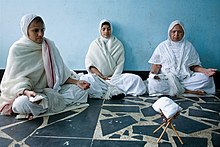Main and important practices of Jainism:
1. Prayers:
The Namokar Mantra is the fundamental prayer of Jainism and may be recited at any time. In this mantra, Jains worship the qualities (gunas) of the spiritually supreme, including those who have already attained salvation, in order to adopt similar behavior. The prayer does not name any one particular person. In Jainism, the purpose of worship or prayer is to break the barriers of worldly attachments and desires and to assist in the liberation of the soul. Jains do not pray for any favors, material goods or rewards.
2. Fasting:
Jains fast throughout the year, particularly during festivals. This takes on various forms and may be practiced based on one's ability. Some examples include: eating only one or two meals per day, drinking only water all day, not eating after sunset, not eating processed foods, eating food without sugar/oil/salt. Two purposes of fasting are to exercise self-control and to clear the mind to devote more mental energy to prayer.
3. Meditation:
Main article: Jain meditation
Jains have developed a type of meditation called samayika, a term derived from the word samaya. The goal of samayika is to achieve a feeling of perfect calmness and to understand the unchanging truth of the self. Such meditation is based on contemplation of the universe and the reincarnation of self. Samayika is particularly important during the Paryushana religious festival. It is believed that meditation will assist in managing and balancing one's passions. Great emphasis is placed on the internal control of thoughts, as they influence behavior, actions and goals.
Jains follow six duties known as avashyakas: samayika (practising serenity), chaturvimshati (praising the tirthankara), vandan (respecting teachers and monks),pratikramana (introspection), kayotsarga (stillness), and pratyakhyana (renunciation).
4. Monasticism:
Main article: Jain monasticism
In Jainism, monasticism is encouraged and respected. Monks and nuns live extremely austere and ascetic lifestyles. They follow the five main vows of Jainism absolutely. Jain monks and nuns have neither a permanent home nor possessions. They do not use vehicles and always travel barefoot from one place to another, irrespective of the distance. They wander from place to place except during the months of Chaturmas. They do not use telephones or electricity. They do not prepare food and live only on what people offer them. Jain monks and nuns also usually keep a cloth for ritual mouth-covering to avoid inadvertently harming micro-organisms in the air. Most will carry a broom-like object called a rayoharan made from dense, thick thread strands to sweep the ground ahead of them or before sitting down to avoid inadvertently crushing small insects.
The monks of Jainism, whose presence is not needed for most Jain rituals, should not be confused with priests. However, some sects of Jainism often employ a pujari, who need not be a Jain, to perform special daily rituals and other priestly duties at the temple.

No comments:
Post a Comment